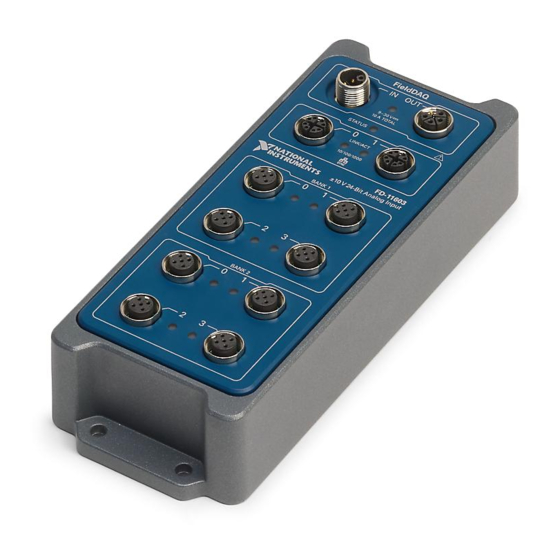
Table of Contents
Advertisement
Quick Links
CALIBRATION PROCEDURE
FD-11603
8-Channel, ±10 V Voltage Input Device for FieldDAQ
This document contains information for calibrating the FD-11603. For more information about
calibration, visit ni.com/calibration.
Contents
Software Requirements............................................................................................................. 1
Documentation.......................................................................................................................... 2
Test Equipment..........................................................................................................................2
Test Conditions..........................................................................................................................3
Calibration Procedure............................................................................................................... 3
Initial Setup....................................................................................................................... 4
Verification........................................................................................................................4
Adjustment........................................................................................................................ 7
EEPROM Update.............................................................................................................. 8
Reverification....................................................................................................................8
Accuracy Under Calibration Conditions...................................................................................8
Signal Connector Pinout........................................................................................................... 9
Where to Go for Support.........................................................................................................10
Software Requirements
Calibrating the FD-11603 requires the installation of NI-DAQmx on the calibration system. NI
recommends using the latest NI-DAQmx driver. Earliest driver support version for calibrating
the FD-11603 is listed in the following table.
Driver
NI-DAQmx
You can download NI-DAQmx from ni.com/downloads. NI-DAQmx supports many
programming languages, including LabVIEW, LabWindows
Basic .NET. When you install NI-DAQmx, you only need to install support for the application
software that you intend to use.
Table 1. FD-11603 Driver Support
Earliest Version Support for Device Calibration
18.5
™
™
/CVI
, C/C++, C#, and Visual
Advertisement
Table of Contents

Subscribe to Our Youtube Channel
Summary of Contents for National Instruments FD-11603
-
Page 1: Table Of Contents
Where to Go for Support......................10 Software Requirements Calibrating the FD-11603 requires the installation of NI-DAQmx on the calibration system. NI recommends using the latest NI-DAQmx driver. Earliest driver support version for calibrating the FD-11603 is listed in the following table. -
Page 2: Documentation
NI-DAQmx C Reference Help—Provides reference information for NI-DAQmx C functions and NI-DAQmx C properties. Test Equipment The following table lists the equipment required for calibrating your FD-11603. If you do not have the recommended instruments, use the minimum requirements to select substitute equipment. -
Page 3: Test Conditions
22 AWG signal wires Test Conditions The following setup and environmental conditions are required to ensure the FD-11603 meets published specifications: • Keep connections to the device as short as possible. Long cables and wires act as antennas, picking up extra noise that can affect measurements. -
Page 4: Initial Setup
Initial Setup Complete the following steps to set up the FieldDAQ device. Install the software and NI-DAQmx driver as outlined in the FD-11603 Quick Start. Note You must install NI-DAQmx 18.5 or later for device calibration support. Set up the FieldDAQ device as outlined in the FD-11603 Quick Start. - Page 5 0.00105 Positive Full Scale 10.0 9.99525 10.00475 The test limits in this table are derived using the values listed in Accuracy Under Calibration Conditions. Set the calibrator to Operate mode (OPR). FD-11603 Calibration Procedure | © National Instruments | 5...
- Page 6 Compare the average to the limits in Table 3. Repeat steps 3 through 7 for each test point. Disconnect the calibrator from the FieldDAQ device. 10. Connect the calibrator to Bank 2 of the FD-11603, as shown in the following figure. Refer to Signal Connector Pinout for signal connection information.
-
Page 7: Adjustment
Set the calibrator to Standby mode (STBY). Repeat steps d through f for each calibration voltage in the array. Disconnect the calibrator from the FieldDAQ device. Connect the calibrator to Bank 2 of the FD-11603, as shown in the following figure. Refer to Signal Connector Pinout for signal connection information. -
Page 8: Eeprom Update
Where to Go for Support for assistance in returning the device to NI. Accuracy Under Calibration Conditions The values in the following table are based on calibrated scaling coefficients, which are stored in the onboard EEPROM. 8 | ni.com | FD-11603 Calibration Procedure... -
Page 9: Signal Connector Pinout
FD-11603. For operational specifications, refer to the most recent FD-11603 Specifications at ni.com/manuals. Signal Connector Pinout Figure 6. -
Page 10: Where To Go For Support
NI Application Engineers. National Instruments corporate headquarters is located at 11500 North Mopac Expressway, Austin, Texas, 78759-3504. National Instruments also has offices located around the world to help address your support needs. For telephone support in the United States, create your service request at ni.com/support...
















Need help?
Do you have a question about the FD-11603 and is the answer not in the manual?
Questions and answers